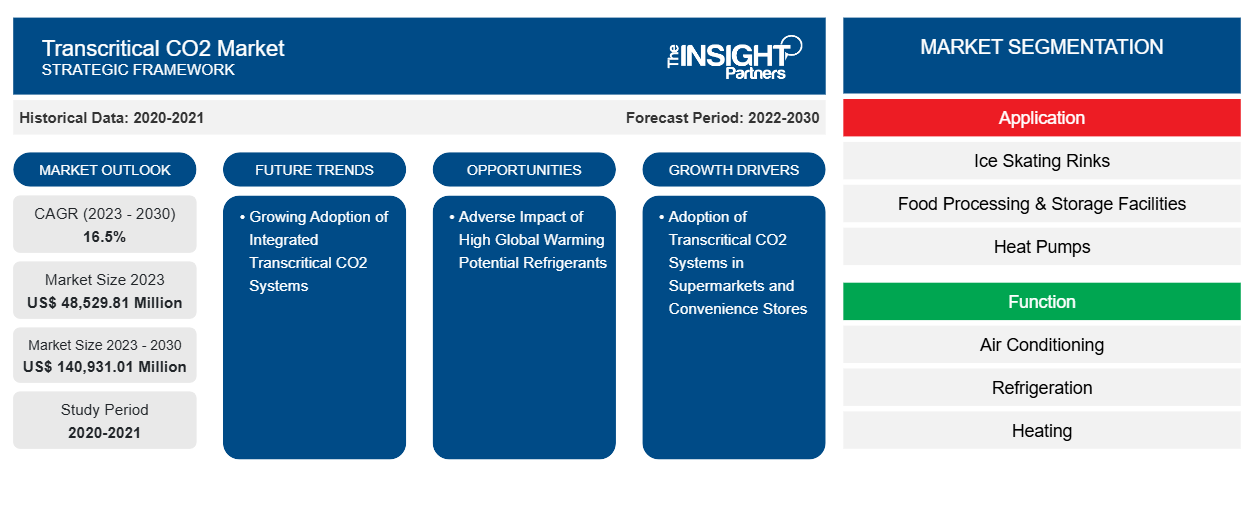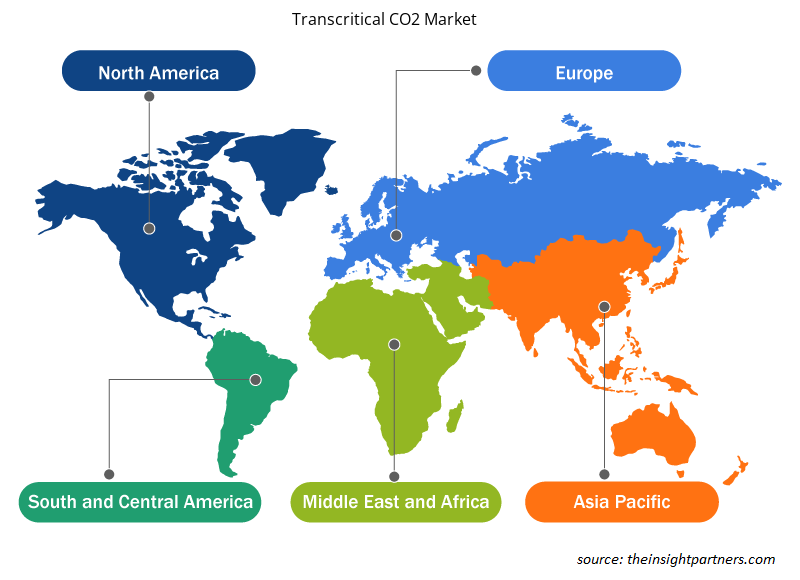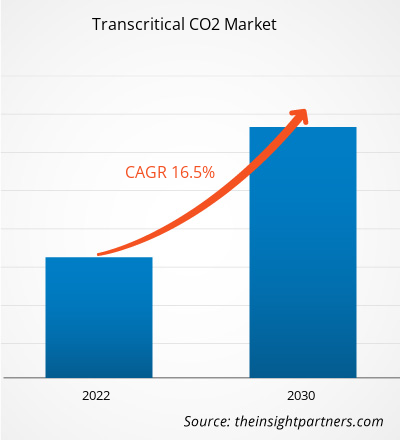Se prevé que el tamaño del mercado de CO2 transcrítico alcance los 156.990 millones de dólares estadounidenses para 2031, frente a los 54.150 millones de dólares estadounidenses de 2024. Se estima que el mercado registrará una tasa de crecimiento anual compuesta (TCAC) del 16,8 % entre 2025 y 2031. Es probable que el uso de CO2 reciclado de residuos en aplicaciones de refrigeración impulse nuevas tendencias en el mercado en los próximos años.
Análisis del mercado del CO2 transcrítico
Los sistemas de CO₂ transcríticos son especialmente adecuados para instalaciones de almacenamiento frigorífico, ya que ofrecen una refrigeración constante con un menor impacto ambiental. El rápido crecimiento de la industria de la cadena de frío, impulsado por la creciente demanda de alimentos congelados y perecederos, es un factor clave que impulsa la necesidad de estos sistemas para fines de refrigeración. Las innovaciones en sistemas de CO₂ transcríticos han ayudado a superar algunos de los desafíos anteriores, como su ineficacia a altas temperaturas ambientales. Desarrollos como la tecnología de eyectores y la compresión paralela han mejorado el rendimiento de los sistemas transcríticos en climas más cálidos, impulsando su aplicabilidad en todo el mundo.
Descripción general del mercado de CO2 transcrítico
El mercado del CO2 transcrítico se centra en la aplicación de dióxido de carbono (CO2) como refrigerante en sistemas transcríticos. Un sistema de CO2 transcrítico funciona por encima de la presión crítica del CO2, lo que lo hace extremadamente eficiente en aplicaciones como refrigeración y calefacción. Estos sistemas están ganando terreno gracias a su funcionamiento ecológico, rentabilidad y cumplimiento normativo, lo que los alinea con los objetivos de eliminación gradual de refrigerantes sintéticos con alto potencial de calentamiento global (PCG). En medio de la continua urbanización en regiones en desarrollo como Asia Pacífico, África y Sudamérica, la creciente penetración de supermercados en India y Brasil crea una oportunidad significativa para la adopción de sistemas de CO2 transcrítico. Los gobiernos de estas regiones también están adoptando políticas ambientales que fomentan la aplicación de refrigerantes naturales. Más allá del comercio minorista y el procesamiento de alimentos, industrias como la farmacéutica, la química y los centros de datos utilizan sistemas de CO2 transcrítico para sus necesidades de refrigeración.
Recibirá personalización de cualquier informe, sin cargo, incluidas partes de este informe o análisis a nivel de país, paquete de datos de Excel, así como también grandes ofertas y descuentos para empresas emergentes y universidades.
Mercado de CO2 transcrítico: Perspectivas estratégicas

-
Obtenga las principales tendencias clave del mercado de este informe.Esta muestra GRATUITA incluirá análisis de datos, desde tendencias del mercado hasta estimaciones y pronósticos.
Impulsores y oportunidades del mercado del CO2 transcrítico
Aumento de la demanda de aire acondicionado de bajo consumo energético en centros de datos de América del Norte y Europa
El creciente número de centros de datos beneficia al mercado de CO2 transcrítico. Considerando los significativos niveles de consumo energético en las operaciones de los centros de datos, los ingenieros de diseño deben ofrecer sistemas de aire acondicionado fiables y energéticamente eficientes para estas instalaciones. Europa cuenta con una importante presencia de una floreciente industria de centros de datos, con importantes centros como Fráncfort, Londres, Ámsterdam, París y Dublín. Mercados emergentes como Milán, Varsovia y Berlín también están experimentando una rápida expansión. Con la creciente dependencia de los servicios digitales, los centros de datos se están convirtiendo en la columna vertebral de la economía digital europea. Interconectados a través de robustas redes, estos centros de datos facilitan un acceso fluido a internet, lo que eventualmente respalda las operaciones en diversos sectores cruciales, como la medicina, las ciencias de la vida y la banca. Los operadores de centros de datos de toda la región están priorizando progresivamente la sostenibilidad, impulsados por las estrictas regulaciones de la UE sobre emisiones de carbono. En EE. UU., Texas se ha convertido en uno de los centros de datos en crecimiento, gracias a la notable actividad de los operadores de hiperescala. La región occidental de Estados Unidos se posiciona como un mercado desarrollado para centros de datos, que alberga a todas las empresas más importantes, como Meta (antes Facebook), Google y Microsoft, en ubicaciones importantes como Idaho, Oregón, California y Utah.
En marzo de 2024, Carrier presentó las enfriadoras de tornillo refrigeradas por aire AquaForce 30XF con un sistema combinado de enfriamiento libre hidrónico e inversores de velocidad variable, diseñadas para ofrecer una eficiencia energética de hasta aproximadamente el 50 %, específicamente para centros de datos. Los refrigerantes que utilizan HFC se utilizan en algunos equipos de centros de datos, como unidades de aire acondicionado para salas de ordenadores (CRAC), enfriadoras y algunos sistemas de refrigeración en hilera. Varios operadores de centros de datos a gran escala están trabajando para reducir su dependencia de las enfriadoras y han adoptado estrategias de enfriamiento libre que incluyen unidades de tratamiento de aire y aire fresco como alternativas. Los refrigerantes se utilizan comúnmente en centros de datos empresariales para dar soporte a centros de datos de hiperescala y de proveedores de servicios en climas más cálidos donde el enfriamiento libre no es práctico. Los refrigerantes naturales en forma de CO₂ se están utilizando ampliamente en sistemas de refrigeración industriales y comerciales. Por lo tanto, la creciente demanda de sistemas de aire acondicionado y refrigeración energéticamente eficientes impulsa el mercado del CO₂ transcrítico.
Creciente importancia de los refrigerantes de CO2 en las industrias de alimentos y bebidas y farmacéutica
En la industria de alimentos y bebidas, los refrigerantes se utilizan principalmente para mantener un ambiente con temperatura controlada y conservar los productos. La demanda de alimentos procesados, enlatados y fáciles de preparar está aumentando en Estados Unidos debido a la continua urbanización, el aumento de la renta disponible y el ajetreado estilo de vida. Además, su sabor y la facilidad de preparación los hacen populares entre los jóvenes del país. Los alimentos enlatados o de conveniencia requieren instalaciones de almacenamiento adecuadas para mantener su palatabilidad. Los alimentos procesados tienen una alta probabilidad de pudrirse en pocos días o semanas si no se conservan correctamente. Una temperatura óptima y unas condiciones de almacenamiento adecuadas son fundamentales para prolongar la vida útil de los alimentos procesados o enlatados, lo que genera una mayor demanda de refrigerantes. Por lo tanto, los supermercados y las tiendas de conveniencia suelen tener un impacto ambiental significativo debido a su dependencia de los sistemas de refrigeración para almacenar productos perecederos. La creciente importancia de la sostenibilidad y la responsabilidad ambiental subraya la necesidad de reducir la huella de carbono y las emisiones de gases de efecto invernadero asociadas a estos sistemas de refrigeración. La necesidad de abandonar los refrigerantes de alto PCA representa, por lo tanto, una oportunidad de crecimiento para los proveedores de sistemas de CO2 transcrítico. Dado que los sistemas de CO2 transcrítico ayudan a aliviar el impacto ambiental vinculado con los refrigerantes convencionales y se alinean con los objetivos de sostenibilidad, la demanda de soluciones sostenibles seguirá beneficiando al mercado de CO2 transcrítico también en el futuro.
Análisis de segmentación del informe de mercado de CO2 transcrítico
Los segmentos clave que contribuyeron a la derivación del análisis del mercado de CO2 transcrítico son la aplicación y la función.
- En términos de aplicación, el mercado se clasifica en pistas de patinaje sobre hielo, instalaciones de procesamiento y almacenamiento de alimentos, bombas de calor, supermercados y tiendas de conveniencia, entre otros. Este segmento dominó el mercado en 2024.
- Por función, el mercado se clasifica en aire acondicionado, refrigeración y calefacción. El segmento de refrigeración dominó el mercado en 2024.
Análisis de la cuota de mercado del CO2 transcrítico por geografía
El mercado del CO2 transcrítico se segmenta en cinco regiones principales: América del Norte, Europa, Asia Pacífico (APAC), Oriente Medio y África (MEA) y América del Sur y Central (SAM). América del Norte dominó el mercado en 2024, seguida de Europa y Asia Pacífico.
El mercado de CO2 transcrítico está segmentado en cinco regiones principales: América del Norte, Europa, Asia Pacífico (APAC), Oriente Medio y África (MEA), y América del Sur y Central. En 2024, Europa lideró el mercado con una participación sustancial en los ingresos, seguida de Asia Pacífico. Además, se espera que América del Norte registre la CAGR más alta en el mercado de CO2 transcrítico de 2025 a 2031. El mercado de CO2 transcrítico en Europa está subsegmentado en Alemania, Francia, Italia, el Reino Unido, Rusia y el resto de Europa. La región ha experimentado un aumento en el número de instalaciones de almacenamiento frigorífico. Según la Asociación Europea de Almacenamiento Frío y Logística (ECSLA), Europa cuenta con miles de cámaras frigoríficas con más de 60.000 m³ de capacidad de almacenamiento frigorífico para diversos productos básicos. Además, los países europeos han implementado normas y regulaciones para tener un control estricto sobre las emisiones de gases fluorados de efecto invernadero y sustancias que agotan la capa de ozono. Por tanto, con la ley F-Gas y el plan de eliminación progresiva de HFC, se espera que el mercado de sistemas de CO2 transcrítico en Europa crezca a un ritmo notable en el futuro.
Perspectivas regionales del mercado de CO2 transcrítico
Los analistas de Insight Partners han explicado detalladamente las tendencias y los factores regionales que influyen en el mercado de CO2 transcrítico durante el período de pronóstico. Esta sección también analiza los segmentos y la geografía del mercado de CO2 transcrítico en Norteamérica, Europa, Asia Pacífico, Oriente Medio y África, y Sudamérica y Centroamérica.

- Obtenga los datos regionales específicos para el mercado de CO2 transcrítico
Alcance del informe de mercado de CO2 transcrítico
| Atributo del informe | Detalles |
|---|---|
| Tamaño del mercado en 2024 | US$ 54.15 mil millones |
| Tamaño del mercado en 2031 | US$ 156.99 mil millones |
| CAGR global (2025-2031) | 16,8% |
| Datos históricos | 2021-2023 |
| Período de pronóstico | 2025-2031 |
| Segmentos cubiertos |
Por aplicación
|
| Regiones y países cubiertos |
América del norte
|
| Líderes del mercado y perfiles de empresas clave |
|
Densidad de actores del mercado de CO2 transcrítico: comprensión de su impacto en la dinámica empresarial
El mercado del CO2 transcrítico está creciendo rápidamente, impulsado por la creciente demanda del usuario final debido a factores como la evolución de las preferencias de los consumidores, los avances tecnológicos y un mayor conocimiento de los beneficios del producto. A medida que aumenta la demanda, las empresas amplían su oferta, innovan para satisfacer las necesidades de los consumidores y aprovechan las tendencias emergentes, lo que impulsa aún más el crecimiento del mercado.
La densidad de actores del mercado se refiere a la distribución de empresas o compañías que operan en un mercado o sector en particular. Indica cuántos competidores (actores del mercado) hay en un mercado determinado en relación con su tamaño o valor total.
Las principales empresas que operan en el mercado de CO2 transcrítico son:
- TEKO Gesellschaft für Kaltetechnik GmbH
- Baltimore Aircoil Co
- BITZER Kuhlmaschinenbau GmbH
- Carrier Global Corp
- Danfoss AS
- Corporación Hussmann
Descargo de responsabilidad : Las empresas enumeradas anteriormente no están clasificadas en ningún orden particular.

- Obtenga una descripción general de los principales actores clave del mercado de CO2 transcrítico
Noticias y desarrollos recientes del mercado de CO2 transcrítico
El mercado del CO2 transcrítico se evalúa mediante la recopilación de datos cualitativos y cuantitativos tras la investigación primaria y secundaria, que incluye importantes publicaciones corporativas, datos de asociaciones y bases de datos. A continuación, se enumeran algunos de los desarrollos clave del mercado:
- CoolSys anunció la adquisición de Universal Refrigeration, Inc. (Fuente: CoolSys, comunicado de prensa, junio de 2025)
- Evapco, fabricante de equipos originales (OEM) de sistemas y componentes de refrigerantes naturales con sede en Maryland, presentó sistemas empaquetados de amoníaco de baja carga (refrigeradores y enfriadores de ático) y CO₂ transcrítico en la Conferencia y Exposición IIAR, celebrada del 12 al 15 de marzo en Long Beach, California. (Fuente: Evapco, comunicado de prensa, abril de 2023)
- Emerson (EE. UU.) anunció la expansión de su portafolio de compresión de CO2 con el lanzamiento del primer compresor de tornillo transcrítico de CO2 de la industria. (Fuente: Emerson, comunicado de prensa, marzo de 2023)
- Hussmann, una empresa de Panasonic, amplía su oferta de sistemas de refrigeración de CO2 con la incorporación de una unidad condensadora de CO2 (OCU) para exteriores. La OCU está diseñada para aplicaciones de temperatura media o baja, lo que proporciona versatilidad y eficiencia para la refrigeración minorista. (Fuente: Hussmann, comunicado de prensa, diciembre de 2024)
Cobertura y resultados del informe del mercado de CO2 transcrítico
El informe "Tamaño y pronóstico del mercado de CO2 transcrítico (2025-2031)" ofrece un análisis detallado del mercado que abarca las siguientes áreas:
- Tamaño del mercado de CO2 transcrítico y pronóstico a nivel global, regional y nacional para todos los segmentos clave del mercado cubiertos bajo el alcance
- Tendencias del mercado de CO2 transcrítico, así como dinámicas del mercado como impulsores, restricciones y oportunidades clave
- Análisis PEST y FODA detallado
- Análisis del mercado de CO2 transcrítico que abarca las tendencias clave del mercado, el marco global y regional, los principales actores, las regulaciones y los desarrollos recientes del mercado.
- Análisis del panorama industrial y de la competencia que abarca la concentración del mercado, el análisis de mapas de calor, los actores principales y los desarrollos recientes del mercado de CO2 transcrítico.
- Perfiles detallados de empresas
- Análisis histórico (2 años), año base, pronóstico (7 años) con CAGR
- Análisis PEST y FODA
- Tamaño del mercado, valor/volumen: global, regional y nacional
- Industria y panorama competitivo
- Conjunto de datos de Excel
Informes recientes
Informes relacionados
Testimonios
Razón para comprar
- Toma de decisiones informada
- Comprensión de la dinámica del mercado
- Análisis competitivo
- Información sobre clientes
- Pronósticos del mercado
- Mitigación de riesgos
- Planificación estratégica
- Justificación de la inversión
- Identificación de mercados emergentes
- Mejora de las estrategias de marketing
- Impulso de la eficiencia operativa
- Alineación con las tendencias regulatorias






















 Obtenga una muestra gratuita para - Mercado de CO2 transcrítico
Obtenga una muestra gratuita para - Mercado de CO2 transcrítico